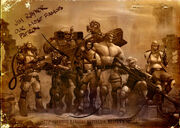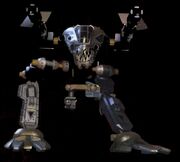
|
You may be looking for:
|
Extended? Why?
Because, gentlemen, we are now officially at war with the Kel-Morian Combine."
- Major General Brantigan Fole and Captain Arcturus Mengsk at the start of the war.(src)
The terran Guild Wars were an economic and military conflict between the Kel-Morian Combine based out of Moria and the Terran Confederacy based out of Tarsonis.[3]
Background
When the terrans first arrived in the Koprulu Sector, they landed on three separate worlds – Moria, Tarsonis and Umoja and were unaware of each other. They had to rebuild their societies and technologies almost from scratch.
The Tarsonian colonists had access to the artificial intelligence ATLAS, giving them a technological edge over the other colonists. It took the Tarsonians sixty years to develop subwarp space technology enough to discover the other colonists, which took all three factions by surprise.
The three planets engaged in trading, but Moria and Umoja rebuffed Tarsonis' attempts to fuse the colonies into a single government. Tarsonis began a program of expansion, creating seven new colonies and creating an interstellar Terran Confederacy.[3]
Economic Conflict
- Bill to Confederate Lieutenant Arcturus Mengsk(src)
The Morian colonists, having the system's richest mines in their control, were afraid that the Confederacy would interfere with their business. As a result a military government, the Kel-Morian Combine was founded to protect all Morian mining guilds that came into conflict with the Confederacy. This led to a rise of tensions between Moria and the Terran Confederacy.[3]
Before the Guild Wars officially broke out, the Confederacy would "steal" Kel-Morian mining claims by sending intelligence personnel to scout the claims, then manufacturing excuses (such as claiming one of the miners was a wanted criminal, or that the claim was illegal), then attack "in order to rectify the situation". During the process, the claim would be taken and generally handed over to an Old Family and guarded by marines and other troops. Areas such as the Paladino Belt and the desert world of Sonyan were subjected to such tactics.[4]
Manpower
- Confederate corporal Thaddeus Timson(src)

Confederate soldiers
Overall, a Confederate soldier had access to better weapons and equipment than his/her Kel-Morian counterpart. The nature of those soldiers was another matter however. Some were volunteers, targeted in recruitment drives aimed at those graduating from secondary level education, the recruitment goals for said drives increasing as the war drew on. Enlistment bonuses were offerred as well. Some individuals however, were drafted illegally. Advanced infantry training (AIT) was cut short in some cases due to the need for additional deployments. During the war, neural resocialization saw widespread, albeit basic use. This piqued Kel-Morian interest.[5]
Due to changes in the Confederate military's command structure during the conflict, several wings of its armed forces were left struggling to adapt. The Internal Security Division further reported a lack of military police in its efforts to keep lawlessness in check.[5]
The Kel-Morian military was essentially composed of irregulars, who often stripped Confederates of armour, weapons and equipment and applied it to their own ends. Kel-Morians were perhaps more ferverant in their dedication to their cause, but were far from angels—controversy stirred up over the Combine's treatment of Confederate P.O.Ws and despite Combine claims to the contrary, such prisoners were sometimes subjected to horrific conditions, even torture.[5]
The Kel-Morians fought alongside unofficial Umojan volunteers.[2]
War Machines
Air/Space Warfare

A battlecruiser
The Kel-Morian Combine used the Hellhound, a laser-armed aerospace fighter, capable of engaging land and air targets. The Confederacy, meanwhile, was using the Avenger, which fired heat-seeking missiles at both land and sky.[5]
Large-scale space warfare was conducted between large battlecruisers and medium-sized gunships. The latter would eventually be replaced by the Confederacy's Wraith fighter, whose superior maneuverability enabled it to dodge laser battery fire.[3] The Wraith, armed with anti-air/space missiles and anti-ground lasers, was in use by 2485.[4]
Ground Combat

The goliath
The Larscorp goliath, which was well-suited to the constant urban warfare, was developed for the Kel-Morians. Corporate information liberators stole the plans for the goliath for the Confederacy, who built them as well.[3] Both sides were using the goliath by 2485.[4]
The siege tank was in use before the Guild Wars by the Terran Confederacy. The versatility of the goliath convinced the Confederacy to develop a mobile stage for the tank.[3] This version of the siege tank was in use by 2480.[4]
Diplomatic Alliances
During the war, Umoja played a role. Volunteers such as Forest Keel[1] and mercenaries such as Graven Hill[2] saw their own share of "friction" during the conflict. Umoja was also supported by the foremen of Pridewater, a Confederate fringe world planet – the foremen had secretly turned against the Confederacy.[1]
Events of the War
- Trace Raynor(src)
Shortly before the war broke out, the Confederacy received reports that the Kel-Morian Combine were planning major operations and would fight in a different manner than previously.[4]
Onuru Sigma
In 2485 the Terran Confederacy confronted the Kel-Morian Combine at the Noranda Glacier vespene refinery at Onuru Sigma. The vespene was contaminated with hydrogen sulfide, rendering it explosive.
By this point, the Confederacy believed the Kel-Morians were planning something big in that area. A detachment of Confederate Alpha Squadron led by Captain Edmund Duke and a detachment of the 33rd Ground Assault Division – Dominion section – led by Captain Arcturus Mengsk advanced on the dilapidated-looking complex, only to fall into an ambush. Many of the "abandoned" structures turned out to be strongpoints.
Duke lost many men recklessly charging the stronghold and had to take shelter in a strongpoint they had captured. Meanwhile Mengsk called on Wraith air support to strafe the complex. As Mengsk's forces approached cautiously, they took fire, and many marines were killed or injured. A Wraith blew up a truck filled with vespene, and eventually the whole complex burst into flame as Mengsk's forces escorted the Alpha Squadron troops to relative safety.
The Confederates retreated, especially when they heard about Kel-Morian brigades and capital ships approaching the area. War was declared, and terms of service increased.[4]
Sonyan
Early in the war, the Confederate 33rd Ground Assault Division returned to Sonyan. They fought a closely-won battle against the Combine at the South Kreen Mines. Confederate First Lieutenant Horace Warfield distinguished himself in battle.[6]
Guerilla War
By late 2487, three of the five zones of the Koprulu Sector where contested between the Confederacy and Combine. During this period, the Confederacy was hard pressed to react to guild guerilla tactics.[5]
Tyrador VIII
In early 2488, Kel-Morians attacked a Confederate refinery on Tyrador VIII. Civilian casualties occurred as a result.[5]
Battles of Char

Char
Char was one of the richest resource nodes in the Sector, and was mined by both Confederate and Morians; the former claimed Char as a "core colony world".
Fierce fighting broke out on Char, and unrestricted usage of nuclear weapons in some areas awoke dormant volcanoes and made the planet even more radioactive and inhospitable to humans than before.[7]
In March 2488, Colonel Trelmont of the 2nd Regiment led Confederate troops in defending nuclear fortifications from Kel-Morian attackers, helping to force them retreat.[5]
Dylar IV
On Dylar IV, in mid-2488, a Kel-Morian special operations team succesfully infilitrated a Confederate base. Seven marines were killed, three were wounded and another was regulated to life support.
At round about the same period of time, an attack was carried out on Confederates stationed at the Dylarian Shipyards. Three soldiers were killed via a grenade.[5]
Raydin III
Raydin III was a battlefield between the two powers, specifically the town of Prosser's Well. The Confederates emerged victorious.[5]
Battles of Turaxis II
- Main article: Turaxis II campaign
During the latter stages of the war, the two sides clashed on Turaxis II. The 321st Colonial Rangers Battalion conducted the most important Confederate missions there.[8]
Other Battles
On Artesia Prime, Kel-Morian rippers frequently softened up Confederate forces with spider mines before conducting raids.[9] A Confederate convoy belonging to the 33rd Ground Assault Division was struck by spider mines. At least one casualty was sustained. The same division's Dominion section saw action on Parragos as well.[4] The Confederacy suffered another loss on Feronis, where a battalion of motorized infantry was defeated in the Battle of Hegeron.[5] The two sides clashed at Gamma Dorian in 2488, where the Confederacy won an initial victory, but many were killed by an exploding bridge.[10] Over the course of the war, the Confederacy "sold out" some of its colonies.[11] The settlement of Pitt Town, New Sydney, a Confederate planet, was destroyed during the war.[12]
The following section contains information from StarCraft II that is ambiguously canonical.
|
Mar Sara was a site of battle during the war. The 321st Colonial Rangers Battalion carried out actions there.[13]
Finale
- Ailin Pasteur(src)
Impending Confederate victory became obvious long before the war officially ended.[4] In April 2489, Confederate representatives agreed to discuss the possibility of a ceasefire.[5] Later in the year, the Confederates declared victory after "negotiating" peace with the Kel-Morian Combine. Moria was left independent, but its supporting guilds were annexed. Shocked at the Confederacy's actions, Umoja founded the Umojan Protectorate, seeking to ensure its independence from "Confederate tyranny." In the end, the war had ensured the Confederacy's place as the dominant power within the Terran Sector.[3]
Home Fronts
During the conflict, the people of the Confederacy had mixed fortunes. Tarsonis survived unscathed and the Old Families made enormous profit from selling weapons and equipment to the Confederate Armed Forces. On the other hand, increases in military spending damaged the Confederate agricultural sector, sending some independent farmers into bankruptcy. Due to the Combine's attempt at resource control, taxes were raised, fuel was rationed and food shortages were experienced. Shiloh served as a notable example. There were even those amongst the Old Families who pushed for a rise on colonial property taxes in order to better recover the cost of military protection—on a per capita basis, it was more expensive to defend a sparsely colonized fringe world than a densely populated one.[5]
Media access to the Confederate military was limited, leading some to cynically dub the conflict as "the quiet war." Airing of uncensored war footage led to a scandal at UNN led to president Preston Shale stepping down. The Confederate line was that were the Kel-Morians to succeed and topple the Confederate government, it would result in effective slavery for all Confederate citizens, as Kel-Morian guilds were hereditary in membership.[5]
On the Combine front, Moria escaped the conflict unharmed.[14]
Legacy
Although on the losing side of the war, Moria founded new mining colonies and provided the Terran Confederacy with so much money that they became effectively immune to Confederate laws.[3] Tarsonis meanwhile enjoyed an economic boom which lasted until war broke out with the Sons of Korhal, protoss and zerg.[15] The Protectorate profited from the war in a sense in that war-weariness prevented the Confederacy from following up on the Protectorate's salvage of its battlecruiser, Hyperion.[16]
The Guild Wars became the subject of a degree of literature, such as the digi-tome History of the Guild Wars[1] and The Guild Wars.[5] The Daughters of the Guild Wars Veterans was a Confederate charity group that honored Confederate soldiers who fought in the wars, errecting memorials for them.[11] In time, the conflict became "legendary."[17]
References
|
| Major Koprulu Conflict | ||
|---|---|---|
| Preceded By | Duration | Succeeded By |
